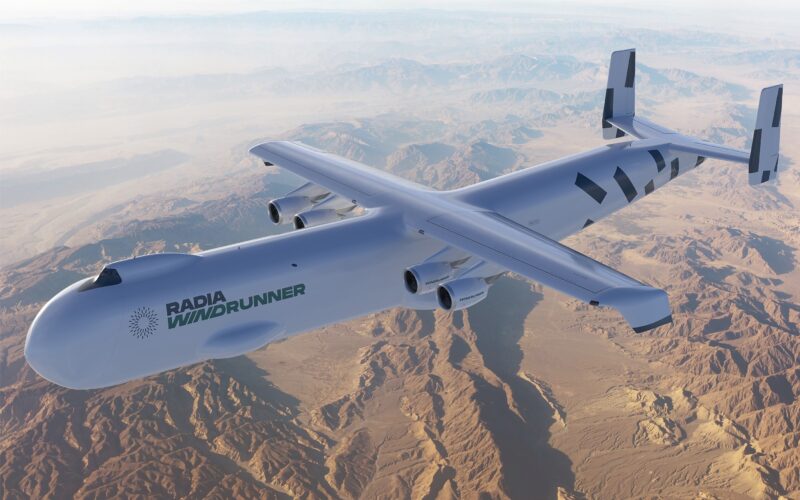Aviation
Meet WindRunner: The World’s Heaviest and Largest Aircraft Ever Built

In the ever-evolving landscape of renewable energy, where innovation meets ambition, a US-based energy start-up named Radia is poised to redefine the future of both aviation and the wind industry.
At the heart of their groundbreaking vision lies the WindRunner, an extraordinary aircraft designed to set new records and revolutionize how we approach clean energy transportation.
WindRunner is not just an aircraft; it is a colossal flying machine that, when fully certified, will hold the title of the largest and heaviest aircraft ever built by humankind.
Unveiling the Future: A Glimpse into the Next Generation of Airbus Wings:Click here
With dimensions that dwarf even the most iconic airplanes in history, WindRunner is a feat of engineering designed to transport the world’s largest onshore wind turbines to remote, hard-to-reach locations—places where conventional transportation methods fall short.
This mammoth aircraft, which spans 356 feet in length, is 127 feet longer than a Boeing 747-400 and boasts a wingspan of 261 feet. Its towering height of 79 feet is a testament to its unparalleled design, tailored specifically to meet the demands of the modern wind industry.
WindRunner’s cargo bay volume is equally impressive, measuring 272,000 cubic feet—enough to accommodate the equivalent of three Olympic swimming pools. To put this into perspective, that’s 12 times the volume of a Boeing 747-400.
10 fastest fighter jets in the world:Click here
But WindRunner’s capabilities extend far beyond its sheer size. It is engineered to transport massive cargoes, including wind turbine blades up to 300 feet in length, directly to wind farms. With a maximum payload capacity of 160,000 pounds, this aircraft can carry cargoes up to 344 feet long, 24 feet high, and 24 feet wide—dimensions that push the boundaries of what was previously thought possible in airborne transportation.
To date, Radia has secured nearly $100 million in funding from a consortium of external investors. This substantial financial backing underscores the confidence in WindRunner’s potential to transform the renewable energy landscape.

Aviation
Airbus Plans Cockpit Toilet to Make Single-Pilot Operations a Reality

In a bold move aimed at cutting costs, Airbus is exploring the possibility of installing a potty-style toilet right behind the Captain’s seat on its A350 long-haul aircraft. According to the reports from paddleyourownkanoo.com
This proposal is part of the ongoing effort to implement Extended Minimum Crew Operations (eMCO), a concept that could revolutionize the aviation industry by reducing the number of pilots required on ultra-long-haul flights.
Air India Invests in Future Talent: 50,000 Staff to Be Trained at New Facility
Currently, on long flights, two pilots stay in the cockpit while the others rest in a separate compartment. However, under eMCO, one pilot could be alone in the cockpit for up to three hours while the other sleeps. The goal is to reduce crew costs and improve airline efficiency, as fewer pilots would be needed for these flights.
But this proposal has raised concerns from pilot unions, who worry about safety and the challenges of single-pilot operations. To address the issue of bathroom breaks, Airbus suggests installing a radio-equipped toilet in the cockpit, allowing the pilot to use it without leaving their seat.
UAE Visa: New Rules and Regulations – These Items Are Now Prohibited in the UAE
If the pilot needs to use the toilet, the second pilot would have to be woken up, terminating the eMCO process temporarily.
If successful, Airbus plans to begin testing this system on its A350 aircraft as soon as 2027, with single-pilot operations possibly being introduced on freighter Airbus A320s within the next five years.
-

 Aviation2 months ago
Aviation2 months agoMicrosoft Flight Simulator Raises $3 Million to Bring Back the An-225 Mriya
-

 Airlines2 months ago
Airlines2 months agoQatar Citizens Can Travel to the United States Without a Visa
-

 Defence2 months ago
Defence2 months agoWhich Country Has the Largest Fleet of Fighter Aircraft?
-

 Airlines1 week ago
Airlines1 week agoDAMAC Air: Dubai’s New Luxury Airline Offers Free Flights for Registration
-

 Airlines1 week ago
Airlines1 week agoAir India to Launch aircraft maintenance training institute in Bengaluru
-

 Airport2 months ago
Airport2 months agoWestern Sydney Airport Welcomes Its First Plane After 6 Years of construction
-

 Aviation2 months ago
Aviation2 months agoDid you know ? Once Boeing 747 carried 1088 passenger in 1991
-

 Travel1 week ago
Travel1 week agoThis country tops visa rejections in the popular Schengen countries








